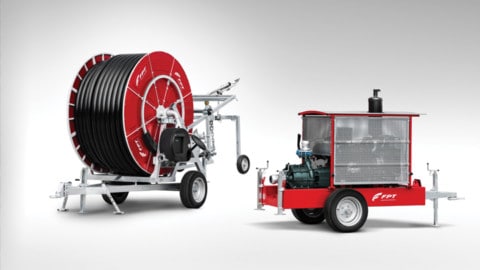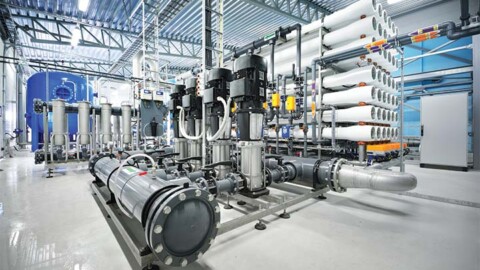Crafting the perfect vintage is an intricate and precise art, and the equipment used in the process can greatly affect the flavour and mouthfeel of the wine. Thus, the pumps used in the winemaking process need to be selected just as carefully as the grapes themselves. Here, we uncork just how pumps are used in winemaking and decant the ideal pump choices to produce a Halliday-approved vintage.
Although winemaking is an art steeped in tradition that as a process has remained relatively unchanged for centuries, one aspect that is constantly evolving is the technology used in this process. As this technology improves, wineries are able to produce more consistent results between vintages, and have more control over the temperature and fermentation conditions.
From filtration to transportation, pumps play a vital role in this winemaking process; and with Australia ranked as the world’s fifth largest wine exporter – producing more than a billion litres of wine every year – wine pumps need to be highly efficient and durable to keep up with this demand.
The winemaking process
Winemaking begins with harvesting or picking the grapes, which are then crushed or pressed to a must (the combination of juice, skins and seeds). For white wines, the juice is filtered out from the skins and seeds of the grapes, while for red varietals the entire must undergoes the primary fermentation.
To begin primary fermentation, yeast is required. This can be added manually to either the must or juice, or occur naturally as ambient yeast on the grapes or in the air. Over the course of one to two weeks the yeast converts the sugars in the grape juice into ethanol and carbon dioxide, the latter of which dissipates into the atmosphere.
This liquid, known as free wine, is then pumped into tanks. With red varietals, the skins are pressed again to extract the remaining liquid, which is called press wine. This press wine is then blended with the free wine at the winemaker’s discretion to bring more flavour and
longevity to the wine. The wine is then kept warm in the tanks and a secondary fermentation converts the remaining sugars into alcohol and carbon dioxide.
For sparkling wines, the wine is often pumped instead into the bottle that the wine will be sold in, along with additional yeast and sugar, and this secondary fermentation takes place within that bottle.
For red wines, this secondary fermentation process can also result in malolactic fermentation, a bacterial process that converts the tart malic acid into softer, creamier, lactic acid, which softens the taste of the wine. For this, red wines are sometimes transferred into oak barrels to mature, which adds oak aromas and tannins to the wine. The wine is then settled or clarified and adjusted as needed before being filtered and bottled.
Picking the right pump
Pumps are used at almost every stage of the winemaking and transportation process, including wine transfer, filtration, bottling, unloading trucks, unloading tank wagons and unloading ships. As wine is an incredibly delicate product, there needs to be great care taken when selecting the equipment used to move it.
Even the slightest change in temperature can affect the final product, and too much force and agitation can impact the consistency of the wine. In general, there are two main types of pump required within a winery: a wine pump and a must pump. As the name suggests, must pumps are used to transfer the juice and skins of the grapes.
This can be from to the fermenter from the crusher, or to pump the fermenting wine over itself and to break up the cap, which forms when the grape solids rise to the surface in the fermenter. Must pumps are designed to pass solids through the pump head, and have powerful, heavy duty motors designed to push the thick must.
Conversely, wine pumps are not made to move solids, and are used to transfer wine post pressing for filtration, bottling and racking.
An ideal pump for moving wine and wine must should:
• Minimise shearing and agitation of the wine
• Have equipment that is portable and can be easily operated by winery personnel
• Be suitable for sediment and solids
• Prevent the wine’s exposure to too much oxygen
• Be easily variable between low and high transfer rates
• Be self-priming
• Be easy to clean and sanitise, and designed for foodgrade service
Different pumps have different characteristics and capabilities when it comes to moving liquid, and these characteristics can make a particular pump design more or less suitable for a winemaking application. While many offer certain features that meet the demands of the wine industry, some of those technologies can also come with inefficiencies.
Piston pumps
Piston pumps are built around the concept of a reciprocating piston alternately sucking in low-pressure fluid then compressing and discharging the fluid to a high-pressure area. The piston can be connected to either a crankshaft or a swash plate, but in both cases the pumping concept is the same.
These pumps are self-priming, and can provide variable flow rates. However, as wine bottling production lines require high flow rates, the disadvantage of a piston pump is that it needs to be quite large in order to achieve these high rates and would not be easily portable.
These pumps also have some tendency to shear and agitate the liquid, and are not as gentle as other options.
Eccentric disc
An eccentric disc pump consists of a cylinder and a pumping element mounted on an eccentric shaft. As the eccentric shaft rotates, the pumping element creates chambers with the cylinder. This increases the size of the intake port and draws fluid into the pumping chamber, which is then transported to the discharge port where the size of the pumping chamber is decreased.
This action squeezes the fluid out into the discharge pipework. This seal-less design offers a gentle transfer of products that reduces shear and prevents leakage, making it ideal for winemaking. Eccentric disc pumps are also self-priming, can run dry and are excellent at clearing tanks and piping, which is well-suited to transferring wine from storage tanks into filters or bottling tanks.

Centrifugal pumps
Centrifugal pumps are a type of rotodynamic pump, which has a shaft-mounted impeller that rotates unidirectionally within the pump casing, moving the liquid from the low-pressure area at the center of the impeller to the higher-pressure zone at the edge of the impeller.
These pumps are more common in large wineries, and are often used for transferring wine from one tank to another. These pumps are easy to maintain and clean, inexpensive, and offer high flow rates. As they do not produce a high discharge pressure, there is minimal risk of containers or hoses rupturing.
The nature of this design however means that the wine will experience significant shearing and agitation while passing through the impeller. Centrifugal pumps also have the potential to homogenise air and trap the oxygen in wine, resulting in oxidation that adversely affects the taste of the wine.
Progressive cavity pumps
Progressive cavity pumps are a type of positive displacement pump, which work by turning a helical rotor within a helix-shaped elastomeric stator. The metal rotor drives the stator through the chain and begins to fill the cavities with equal amounts of liquid that is then pushed through the pump outlet. These pumps are easy to clean, self-priming, portable and easily variable between high and low-flow rates.
As they are also highly tolerant of solids and minimise the shearing and agitation of the pumped fluid, they are ideal for pumping must and extracting juice. The setback to these pumps is their susceptibility to damage in dry-run conditions, where the pump’s contents can burn and seize if it continues to operate after all the wine has been processed.
As the winemaking process relies on manualbatch production operation, this can make these dry-running conditions a common occurrence. As the stator and rotor begin to wear down, there is also the risk of rubber shavings entering the product stream, contaminating the precious wine, and as such preventive maintenance is recommended.
Lobe pumps
A lobe pump (or rotary lobe pump), is another type of positive displacement pump that uses rotating “lobes” to generate flow and move fluid around the interior of the pump. These lobes are driven by external timing gears situated in the gearbox, meaning each lobe rotates independently to generate flow. The external timing gears also prevent the lobes from making contact with each other.
These pumps are commonly used in wine applications, as well as other industries where hygiene is of particular concern, as they offer excellent sanitary qualities along with a high degree of efficiency, reliability, and good clean in place capabilities. In addition to being easily reversible, their portability and low-shear properties also makes lobe pumps favourable for winemaking.
Because the rotating lobes are non-contacting, and clearances within the pump are not as tight as other positive displacement pumps, they generally struggle with lower viscosity fluids, so it’s important to consult the manufacturer on whether a particular pump is suitable for its intended application.
Lobe pumps also include a seal, which increases the risk of leakage. These pumps have ability to handle some suspended solids, however In order to be suitable for must, a larger model is generally required, which can make transfer between wineries more difficult.

Peristaltic pumps
A peristaltic pump (or hose/tube pumps) is another variation of a positive displacement pump that operates on the peristaltic principle.
The pump works by turning a lobed shaft that progressively squeezes a soft tube filled with fluid, which pushes the fluid out of the pump on the high-pressure side of the housing.
Peristaltic pumps are self-priming, easy to clean, and can run dry. They are also incredibly gentle on fluids and their ability to handle solids makes them suitable for must.However, as the rubber hoses are prone to shedding with age, they need to be changed regularly to prevent contamination.
Diaphragm pumps
Diaphragm pumps are positive displacement pumps that work by contracting a rubber diaphragm to pull fluid into a chamber through an inlet valve, the diaphragm then expands to push fluid out of the chamber through an outlet valve. These pumps are incredibly versatile and are a popular choice in the wine industry thanks to their gentle handling of the wine.
Diaphragm pumps are low-maintenance, highly portable, easy to clean, and can run dry. As they also have no seals, there is minimal risk of leakage and contamination of the wine.
Flexible impeller pumps
A type of positive displacement pump, flexible impeller (or flexible member / flexible vane) pumps use a rubber impeller that rotates and creates a vacuum to draw the fluid into the pump inlet, which is then carried between the blades of the impeller and the casing, before being directed to and pushed out of the discharge.
These pumps are easy to clean, offer high flow capacity, and can run at different speeds and accommodate differing viscosity types.
This pump offers a gentle pumping action that ensures the consistency of the fluid is unaffected by shear forces. While they are ideal
for transferring wine, flexible impeller pumps struggle with moving solids, making them unsuitable for transferring wine must.
These pumps will also overheat if they run dry, which will damage both the pump and the wine. Like the grape varietals themselves, each type of wine pump has its own unique characteristics that will shine in the right application, or fail given the wrong conditions.
Depending on the size, scale and varietals used in a vineyard, the requirements of a wine pump will vary, and the best way to ensure that you are choosing the right pump for a winemaking application is to consult a pump supplier or industry expert.

















